Abstract
OBJECTIVES. The primary hypothesis of COMMIT (Community Intervention Trial for Smoking Cessation) was that a community-level, multi-channel, 4-year intervention would increase quit rates among cigarette smokers, with heavy smokers (> or = 25 cigarettes per day) of priority. METHODS. One community within each of 11 matched community pairs (10 in the United States, 1 in Canada) was randomly assigned to intervention. Endpoint cohorts totaling 10,019 heavy smokers and 10,328 light-to-moderate smokers were followed by telephone. RESULTS. The mean heavy smoker quit rate (i.e., the fraction of cohort members who had achieved and maintained cessation at the end of the trial) was 0.180 for intervention communities versus 0.187 for comparison communities, a nonsignificant difference (one-sided P = .68 by permutation test; 90% test-based confidence interval (CI) for the difference = -0.031, 0.019). For light-to-moderate smokers, corresponding quit rates were 0.306 and 0.275; this difference was significant (P = .004; 90% CI = 0.014, 0.047). Smokers in intervention communities had greater perceived exposure to smoking control activities, which correlated with outcome only for light-to-moderate smokers. CONCLUSIONS. The impact of this community-based intervention on light-to-moderate smokers, although modest, has public health importance. This intervention did not increase quit rates of heavy smokers; reaching them may require new clinical programs and policy changes.
Full text
PDF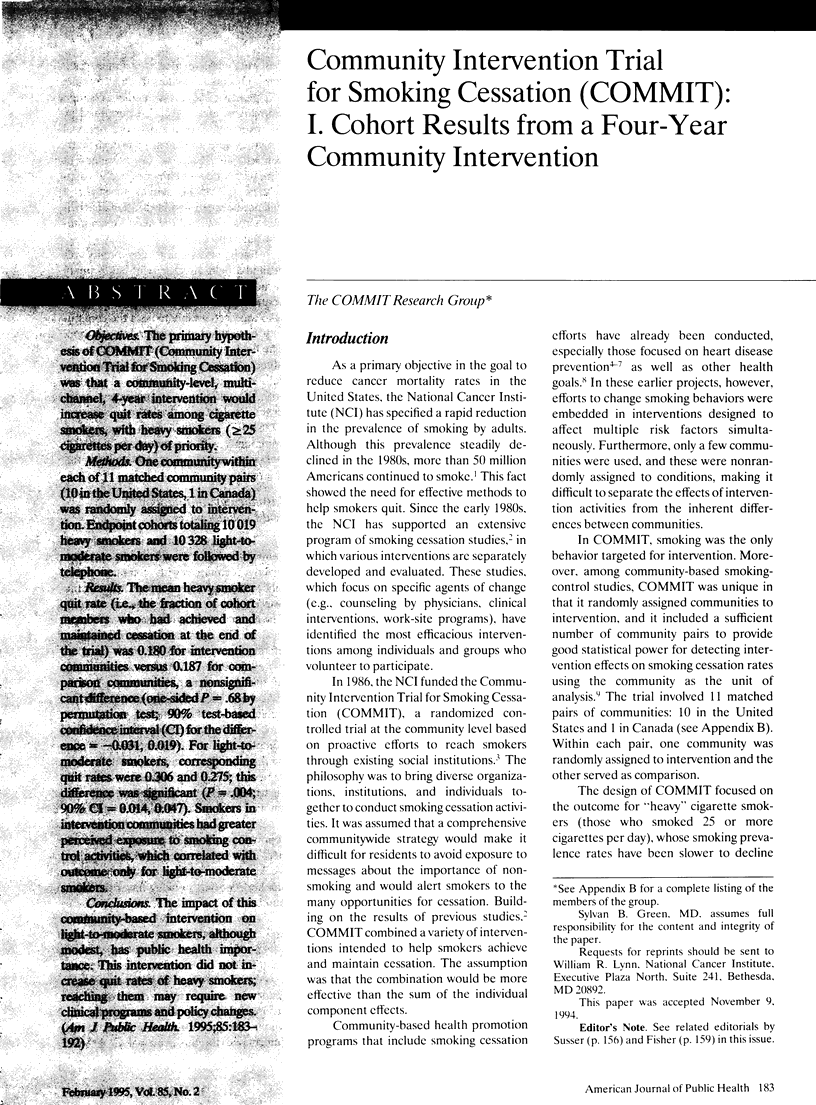

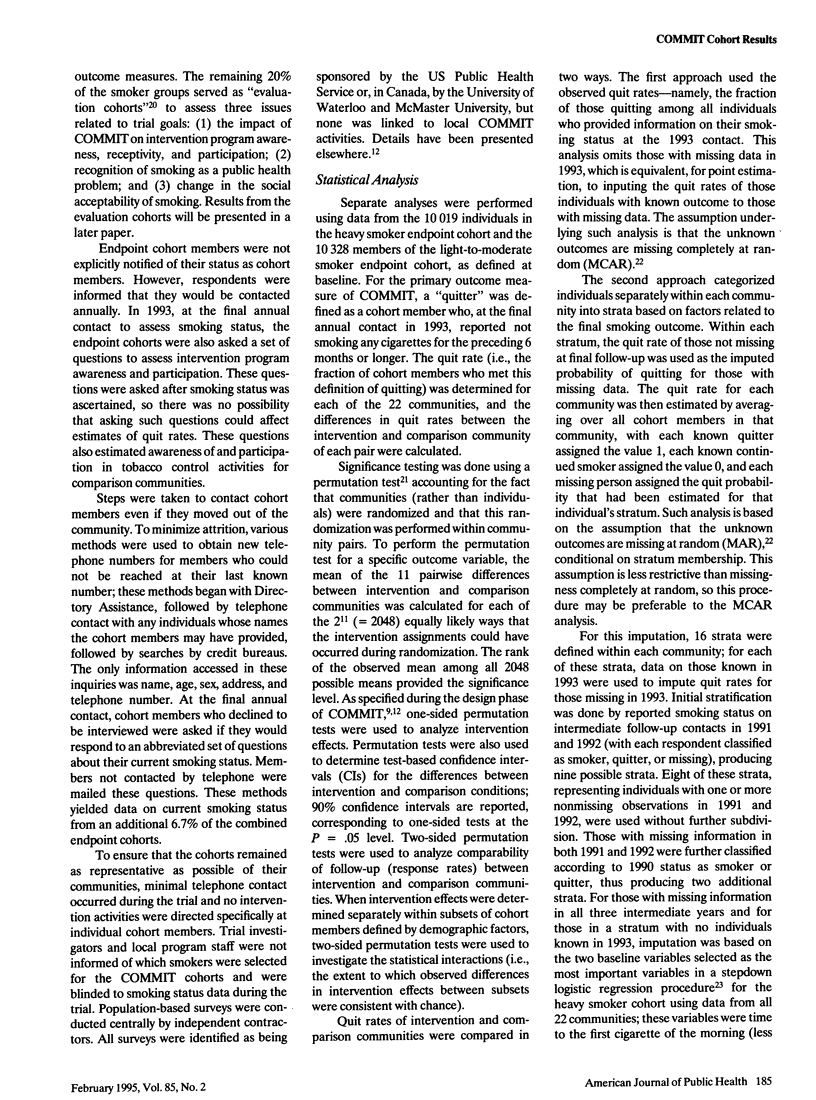
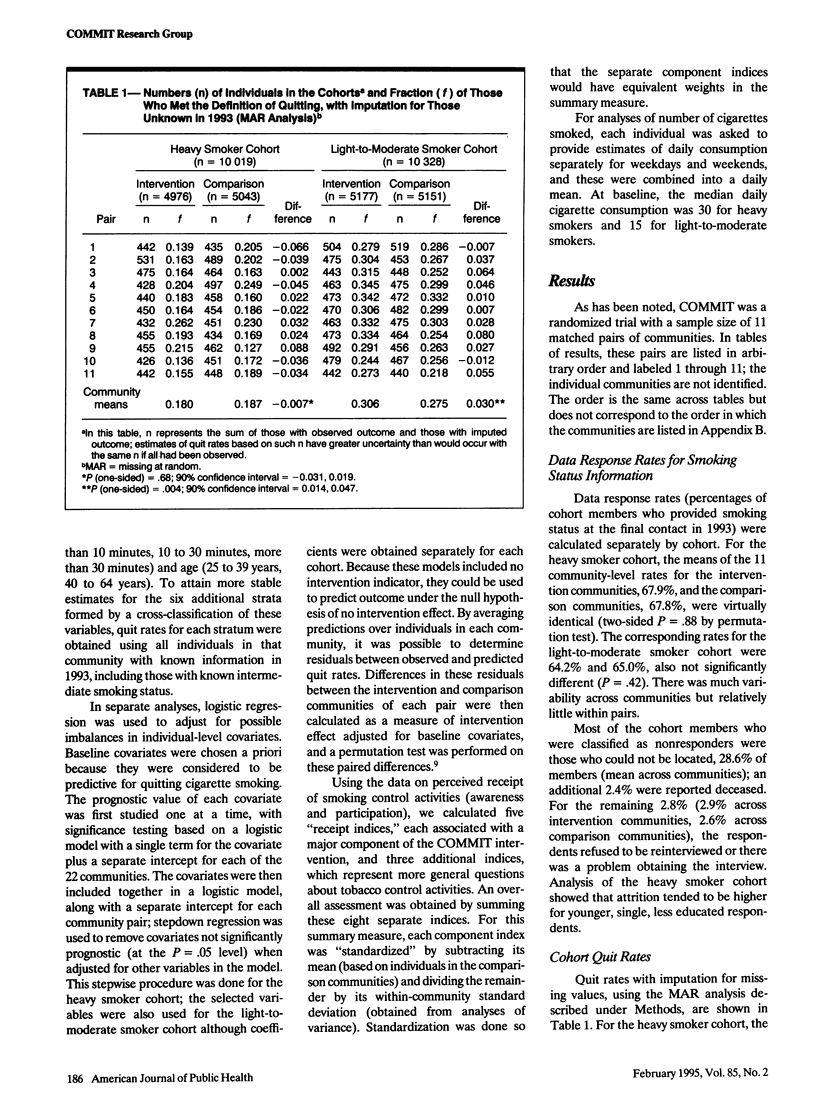
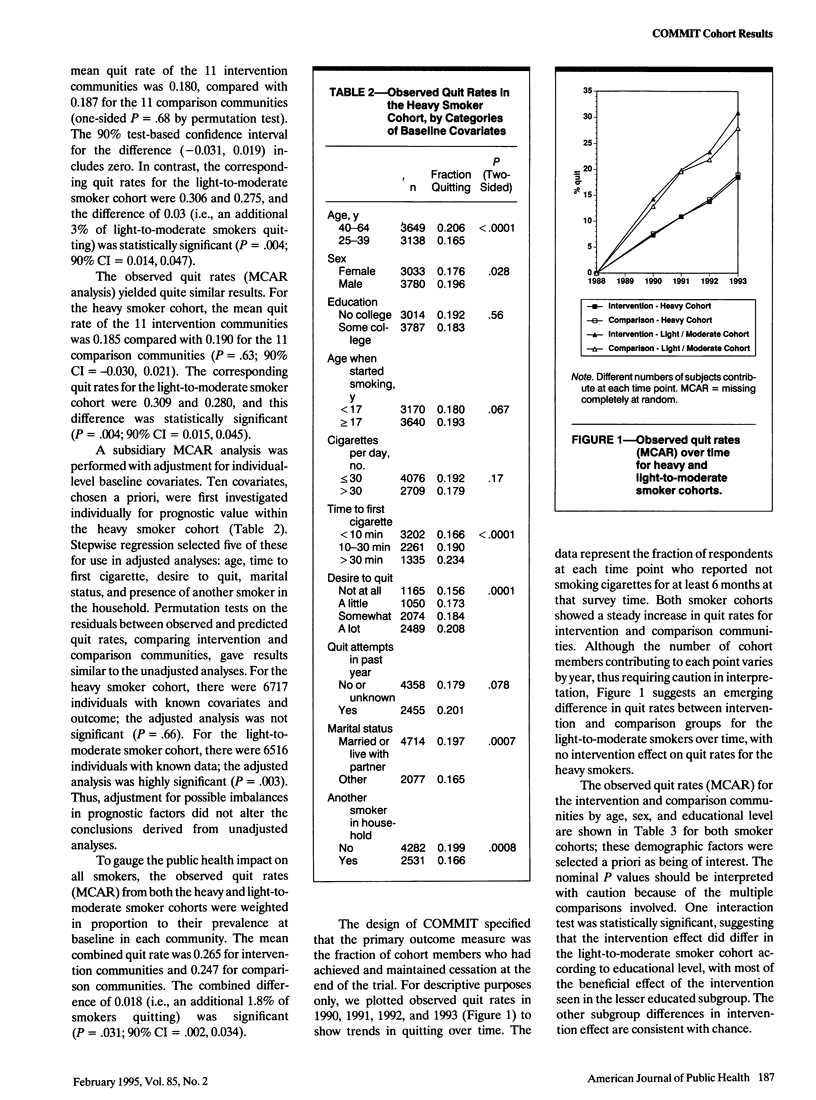



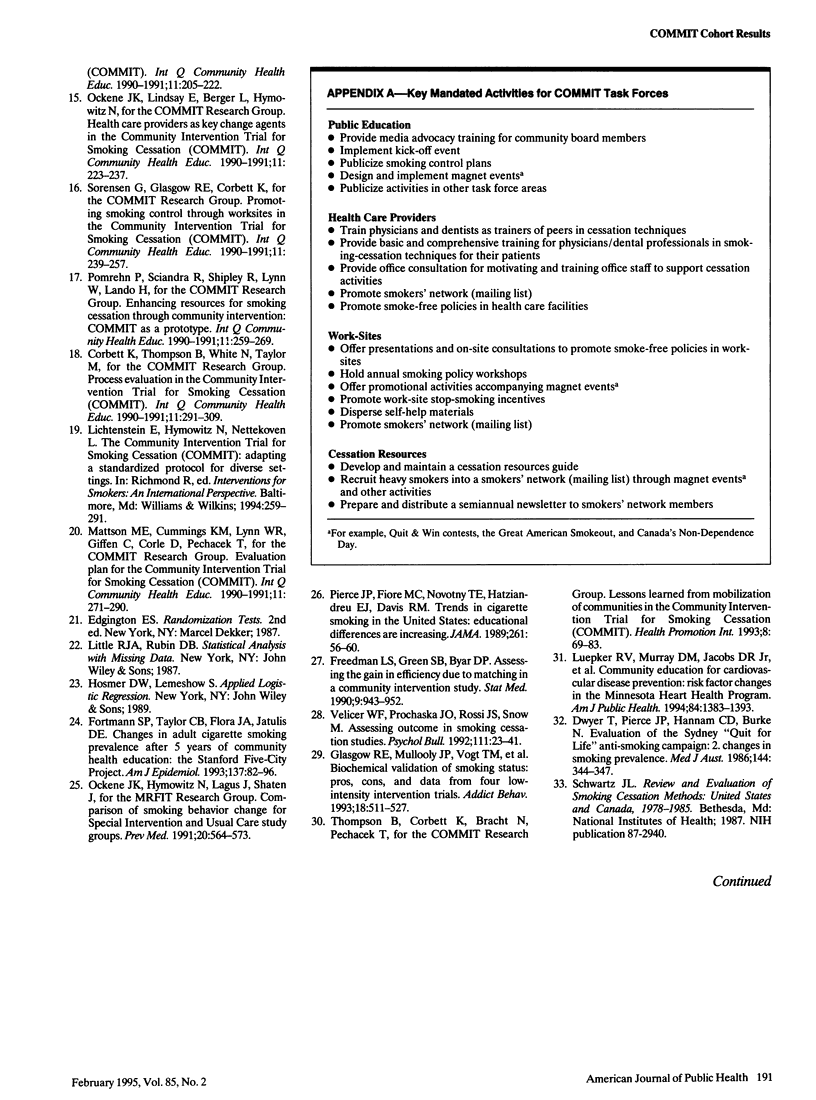

Selected References
These references are in PubMed. This may not be the complete list of references from this article.
- Carleton R. A., Lasater T. M., Assaf A., Lefebvre R. C., McKinlay S. M. The Pawtucket Heart Health Program: I. An experiment in population-based disease prevention. R I Med J. 1987 Dec;70(12):533–538. [PubMed] [Google Scholar]
- Dwyer T., Pierce J. P., Hannam C. D., Burke N. Evaluation of the Sydney "Quit. For Life" anti-smoking campaign. Part 2. Changes in smoking prevalence. Med J Aust. 1986 Mar 31;144(7):344–347. [PubMed] [Google Scholar]
- Egger G., Fitzgerald W., Frape G., Monaem A., Rubinstein P., Tyler C., McKay B. Results of large scale media antismoking campaign in Australia: North Coast "Quit for Life" programme. Br Med J (Clin Res Ed) 1983 Oct 15;287(6399):1125–1128. doi: 10.1136/bmj.287.6399.1125. [DOI] [PMC free article] [PubMed] [Google Scholar]
- Farquhar J. W., Fortmann S. P., Flora J. A., Taylor C. B., Haskell W. L., Williams P. T., Maccoby N., Wood P. D. Effects of communitywide education on cardiovascular disease risk factors. The Stanford Five-City Project. JAMA. 1990 Jul 18;264(3):359–365. [PubMed] [Google Scholar]
- Fortmann S. P., Taylor C. B., Flora J. A., Jatulis D. E. Changes in adult cigarette smoking prevalence after 5 years of community health education: the Stanford Five-City Project. Am J Epidemiol. 1993 Jan 1;137(1):82–96. doi: 10.1093/oxfordjournals.aje.a116605. [DOI] [PubMed] [Google Scholar]
- Freedman L. S., Green S. B., Byar D. P. Assessing the gain in efficiency due to matching in a community intervention study. Stat Med. 1990 Aug;9(8):943–952. doi: 10.1002/sim.4780090810. [DOI] [PubMed] [Google Scholar]
- Gail M. H., Byar D. P., Pechacek T. F., Corle D. K. Aspects of statistical design for the Community Intervention Trial for Smoking Cessation (COMMIT). Control Clin Trials. 1992 Feb;13(1):6–21. doi: 10.1016/0197-2456(92)90026-v. [DOI] [PubMed] [Google Scholar]
- Glasgow R. E., Mullooly J. P., Vogt T. M., Stevens V. J., Lichtenstein E., Hollis J. F., Lando H. A., Severson H. H., Pearson K. A., Vogt M. R. Biochemical validation of smoking status: pros, cons, and data from four low-intensity intervention trials. Addict Behav. 1993 Sep-Oct;18(5):511–527. doi: 10.1016/0306-4603(93)90068-k. [DOI] [PubMed] [Google Scholar]
- Luepker R. V., Murray D. M., Jacobs D. R., Jr, Mittelmark M. B., Bracht N., Carlaw R., Crow R., Elmer P., Finnegan J., Folsom A. R. Community education for cardiovascular disease prevention: risk factor changes in the Minnesota Heart Health Program. Am J Public Health. 1994 Sep;84(9):1383–1393. doi: 10.2105/ajph.84.9.1383. [DOI] [PMC free article] [PubMed] [Google Scholar]
- Mittelmark M. B., Luepker R. V., Jacobs D. R., Bracht N. F., Carlaw R. W., Crow R. S., Finnegan J., Grimm R. H., Jeffery R. W., Kline F. G. Community-wide prevention of cardiovascular disease: education strategies of the Minnesota Heart Health Program. Prev Med. 1986 Jan;15(1):1–17. doi: 10.1016/0091-7435(86)90031-9. [DOI] [PubMed] [Google Scholar]
- Ockene J. K., Hymowitz N., Lagus J., Shaten B. J. Comparison of smoking behavior change for SI and UC study groups. MRFIT Research Group. Prev Med. 1991 Sep;20(5):564–573. doi: 10.1016/0091-7435(91)90055-9. [DOI] [PubMed] [Google Scholar]
- Pierce J. P., Fiore M. C., Novotny T. E., Hatziandreu E. J., Davis R. M. Trends in cigarette smoking in the United States. Educational differences are increasing. JAMA. 1989 Jan 6;261(1):56–60. [PubMed] [Google Scholar]
- Puska P., Nissinen A., Tuomilehto J., Salonen J. T., Koskela K., McAlister A., Kottke T. E., Maccoby N., Farquhar J. W. The community-based strategy to prevent coronary heart disease: conclusions from the ten years of the North Karelia project. Annu Rev Public Health. 1985;6:147–193. doi: 10.1146/annurev.pu.06.050185.001051. [DOI] [PubMed] [Google Scholar]
- Syme S. L., Alcalay R. Control of cigarette smoking from a social perspective. Annu Rev Public Health. 1982;3:179–199. doi: 10.1146/annurev.pu.03.050182.001143. [DOI] [PubMed] [Google Scholar]
- Velicer W. F., Prochaska J. O., Rossi J. S., Snow M. G. Assessing outcome in smoking cessation studies. Psychol Bull. 1992 Jan;111(1):23–41. doi: 10.1037/0033-2909.111.1.23. [DOI] [PubMed] [Google Scholar]


